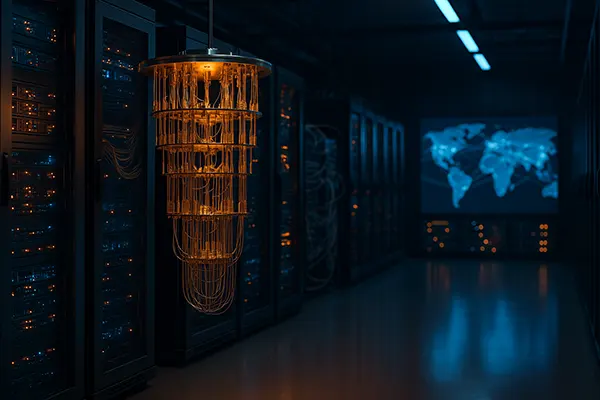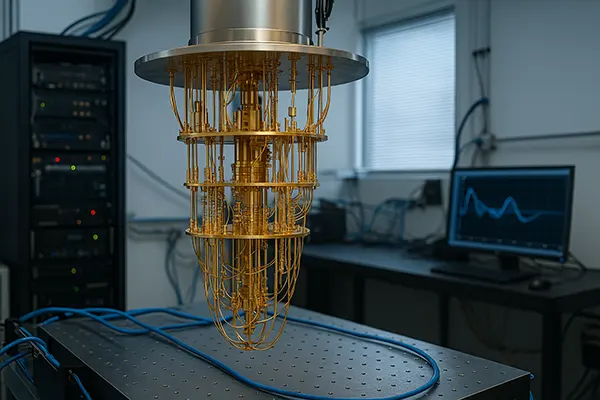
Quantum Internet: The Next Leap in Data Security
The concept of a quantum internet is no longer a far-off dream, but a rapidly approaching reality. As quantum computing continues to evolve, the need for a secure, quantum-based data transmission system becomes increasingly critical. In 2025, the first building blocks of this next-generation internet are being laid, promising a transformative shift in how we protect sensitive data.
How Quantum Internet Works and Why It Matters
Quantum internet uses the principles of quantum mechanics to enable ultra-secure communication. The cornerstone of this technology is quantum entanglement – a phenomenon where particles become linked in such a way that the state of one instantly influences the other, regardless of distance. Unlike classical internet signals, which can be intercepted, quantum data transmission is theoretically unhackable due to the laws of physics.
This new type of network will enable Quantum Key Distribution (QKD), allowing two parties to share encryption keys with absolute security. If an outside observer attempts to eavesdrop, the quantum state of the system is disturbed, alerting the users to a breach. Such security is far superior to today’s encryption, which can be vulnerable to both advanced hacking techniques and the future power of quantum computers themselves.
Countries like China, the USA, and members of the EU are already testing quantum networks. In 2025, China has expanded its quantum communication backbone across thousands of kilometres, while the EU’s Quantum Internet Alliance is connecting research hubs to form a prototype quantum network across Europe. This global race illustrates how crucial the technology is becoming to national security and innovation.
Real-World Applications and Strategic Importance
The implications of quantum internet extend beyond government espionage or cybersecurity. Financial institutions, healthcare providers, and critical infrastructure operators are all eyeing quantum communications to shield their systems from evolving threats. With sensitive data breaches on the rise, industries are pushing for next-generation defences.
Furthermore, the technology can also facilitate a new class of quantum networks where distributed quantum computing becomes possible. By linking quantum computers via quantum internet, researchers could solve complex problems across multiple systems, revolutionising fields such as drug discovery, materials science, and artificial intelligence training.
Because quantum signals cannot be cloned or intercepted unnoticed, secure voting systems, tamper-proof communications, and digital identity protections are all realistic outcomes. The leap to quantum networks is seen not just as a tech milestone, but as a safeguard for future democracies and economies in a hyper-digital world.
Challenges of Implementing Quantum Internet
Despite its promise, building a quantum internet is fraught with technical and logistical hurdles. Quantum entanglement is notoriously delicate – photons used for entanglement can be lost or decohered over long distances. This is where quantum repeaters and satellite-based infrastructure come into play, both of which are still under active development.
In addition, creating a global standard for quantum protocols is a major obstacle. Just as the early days of the internet required agreement on TCP/IP protocols, so too does the quantum internet demand a consensus on secure quantum messaging and node-to-node communication. As of 2025, only a handful of countries have reached the prototype stage.
Funding and talent shortages also pose risks. Quantum infrastructure is expensive and requires highly specialised knowledge in physics, computer science, and engineering. Without sustained investment and international collaboration, the rollout of a truly global quantum internet could stall or become fragmented along geopolitical lines.
Current Research and Global Collaboration
Key players in the quantum internet race include the EU’s Quantum Flagship initiative, the U.S. Department of Energy’s Quantum Internet Blueprint, and China’s Beijing-Shanghai quantum backbone. Each is pursuing slightly different architectures but with shared goals of secure, scalable communication.
In 2025, the Netherlands-based Quantum Delta NL is one of the first regions to connect multiple cities with entangled nodes. Similarly, NASA and MIT are exploring satellite relays for long-distance quantum entanglement, expanding the possibilities of cross-continental connections.
Global conferences such as the Quantum Tech World Summit have become vital for knowledge exchange, helping bridge efforts across borders. In this early phase, cooperation rather than competition will be key to ensuring that no region is left vulnerable in a quantum-connected world.

Impact on Data Security for Businesses and Individuals
For everyday users and business entities alike, quantum internet means a redefinition of what “secure” means. Encrypted messages, sensitive financial data, and personal information could all be protected by physics itself, not just algorithms that might be cracked in the future.
Tech companies are already integrating post-quantum cryptography into their products in anticipation of quantum networks. From secure messaging apps to cloud storage providers, early adopters are preparing their infrastructure to be compatible with QKD and resistant to quantum decryption attempts.
Moreover, quantum internet may prompt regulatory shifts. Governments will need to update digital rights and data protection laws to reflect the new capabilities and limitations of quantum-secured communication. Ethical concerns around surveillance, privacy, and access must also be addressed proactively.
Future Outlook and Timeline
Experts estimate that small-scale quantum internet deployments will become commercially viable in the early 2030s, with limited services appearing as early as 2026–2027. These networks will likely serve financial sectors and critical infrastructure first, before expanding to consumer applications.
In the meantime, hybrid systems that combine classical and quantum protocols will become the norm. These transitional networks will enable users to benefit from quantum security features without abandoning existing infrastructure entirely.
The path forward will depend on sustained investment, educational initiatives, and public-private partnerships. If these align, the quantum internet could usher in a golden age of cybersecurity, transforming not only how we communicate but how we trust the digital world around us.



